REPOST - CTP Episode of the Day - 04.24.06 – Detour
Today's Cherished Episode: Detour (5x04)
Original Air Date: November 23, 1997
Written By: Frank Spotnitz
Directed By: Brett Dowler
A primeval forest is threatened by encroaching civilization. Its secret inhabitants -- fierce predators with glowing red eyes -- fight back.
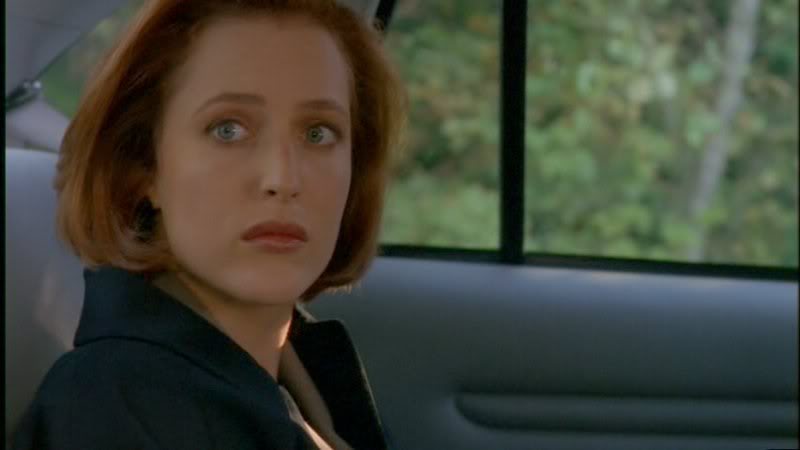

"I was told once that the best way to regenerate body heat was to crawl naked into a sleeping bag with somebody else who's already naked." "Well, maybe if it rains sleeping bags, you'll get lucky."
-- The episode title comes from the fact that Mulder and Scully deviate from their scheduled path -- attending a teambuilding seminar -- and take a detour that leads them to chase mysterious Mothmen through the Apalachicola National Forest in Florida.
-- The farther you stray from civilization, the more capricious -- and cruel -- the forces of nature can become. Somehow, this familiar-sounding truism was overlooked completely by the men and women behind "Detour."
-- The result: a waterlogged nightmare. "Nineteen days of shooting," groaned Brett Dowler -- who, after three seasons as the X-Files's second-unit director, was getting a coveted first shot at directing an episode all his own. "It rained every day -- incredible even for Vancouver," said Dowler. "Almost every scene was outdoors, on location, in daylight. And since it was already deep into the fall, the days were short. We couldn't roll before eight a.m., or after six in the evening. Add in one hour for lunch and three hours to wrap and you can see what we were up against."
-- Since the normal shooting time allotted for one episode was only eight days, the long delay in completing "Detour" put severe strains on both the Vancouver-based producers and the L.A.-based post-production team. Actors' schedules were frantically juggled; chunks of first- and second-unit production time were borrowed from other episodes. Director/producer Kim Manners, who had just finished "Redux II," was brought in to back up Dowler, putting in one day as head of the second unit.
-- Eventually, the company bailed out completely from its principal location in the Seymour Demonstration Forest in North Vancouver. One of the episode's pivotal scenes, in which Scully and the injured Mulder huddle around their campfire in the forest, was filmed in a hastily built stage set in an enclosed -- and dry -- sound stage.
-- It was frustrating. I was sad," said Dowler. "You can't blame anybody for rain in Vancouver, but still, when it started turning into money, everybody remembers the holdups when the bills start coming in."
-- Others had equally vivid memories: such as makeup artist Laverne Basham, who recalled days and days of touching up the actors' moist makeup under umbrellas; sound mixer Michael Williamson, who struggled to keep the sound of rain dripping off nearby leaves out of the dialogue; camera operator Marty McInally, who stumbled into a hole, fell backward, and damaged his equipment while executing a particularly tricky Steadicam shot; and unit production manager Ron French, who discovered one morning that -- for some unfathomable reason -- someone had stolen $1,500 worth of fake rubber tree bark off a real Vancouver tree specifically "dressed" for the occasion.
-- Frank Spotnitz, the episode's writer, said sheepishly, "I thought I'd come up with a very simple concept. Literally, one that was easy for the props people and all the other departments. It was just, well, outside."
-- The episode had its origins, said the X-Files's co-executive producer, during a re-viewing of the film Deliverance. He recalled, "The idea of being stranded in a hostile environment was very interesting to me and so was the idea of something moving in the brush that you can't see. I wanted to insert Mulder and Scully into the story in an atypical way. I just ran with that."
-- After all the rain delays were wrung out of the equation, most of the people associated with "Detour" considered it a solid early-season episode. Not surprisingly, the most interesting special-effects challenge was provided by Spotnitz's concept of prehensile forest creatures able to disappear into their surroundings. At first, the idea was to costume specially selected actors -- cast from Vancouver's Central American community -- in form-fitting "bark suits" that would nearly disappear against the foliage, then be further blended into the background in post-production. Makeup/special effects supervisor Toby Lindala had the bark suits meticulously constructed, but in the end the difficulties were such that most of what was seen of the creatures was created electronically.
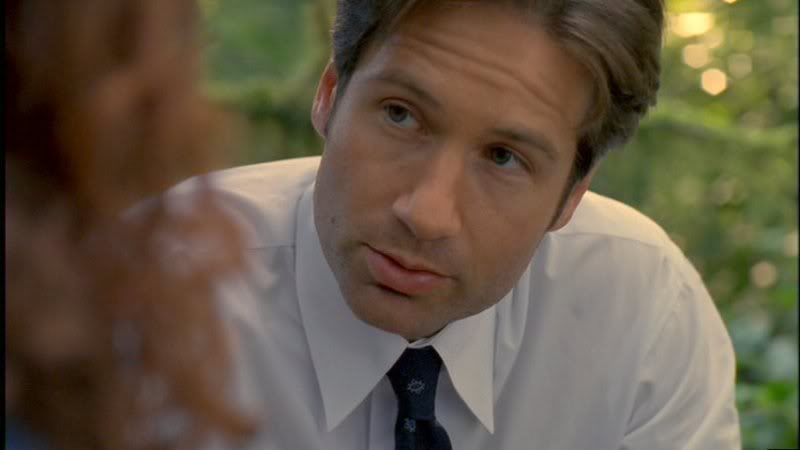
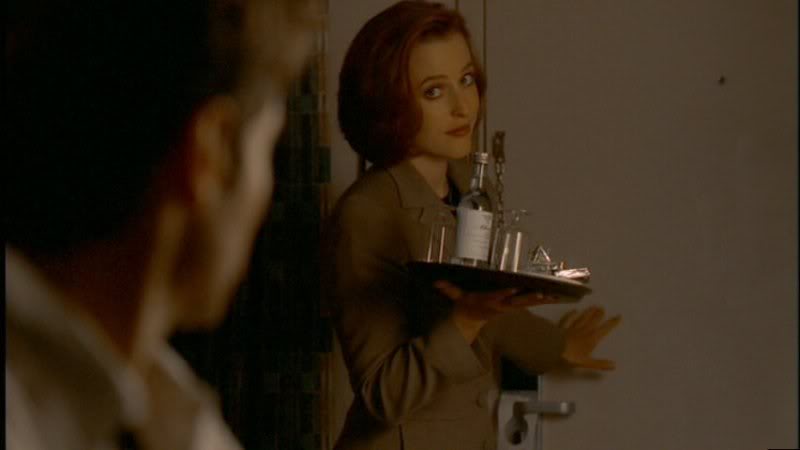
-- To computer generate the creatures' glowing red eyes, visual effects supervisor Laurie Kallsen-George blended and modified a number of digitized eyeball images, including those of her family's female half-Labrador retriever, Danny, whom she photographed in her backyard while shining a flashlight in the dog's face.
-- Other inspired improvisations included the agents' Dilbertian "team builder" exercise, which was contributed by Vince Gilligan during the rewrite process. Glaser's FLIR device was actually a Sony Watchman, modified by propmaster Ken Hawryliw and hooked up to an infrared camera.
-- And Scully sang! In Frank Spotnitz's original draft, Dana Scully's campfire song was Hank Williams's I'm So Lonesome I Could Cry. However, his boss Chris Carter requested something "off the wall and strange," and the immortal Joy to the World was substituted.
-- "In retrospect, the song was perfect," said Frank Spotnitz. Indeed, Gillian Anderson's rendition made such an impression that she was asked to sing it again -- and did so -- during a personal appearance at an X-Files Expo in New York City.
-- As for Anderson herself, she recalled "Detour" vividly as being "a pain in the butt." She also maintained steadfastly that she remained totally in character throughout it. "In that scene I sang intentionally badly," she said. "In real life I could do a lot better than that."
-- One "pain in the butt" of the episode was Anderson's hair, which went from straight to curly and back to straight again between scenes. The production crew was aware of the problem when they were shooting the episode, but couldn't do anything about it as the heavy rain brought out the natural curl in Anderson's hair.
-- "Detour" took place in Leon County, Florida, which is in northern Florida and home to Florida's capital, Tallahassee. Leon County was named after the Spanish explorer, or conquistador, Juan Ponce de Leon, referenced by Mulder and Agent Kinsley in the episode.
-- Ponce de Leon was one of 200 "gentleman volunteers" who joined 1,200 sailors, colonists, and soldiers on Christopher Columbus's second voyage to the Americas in 1493. The fleet reached the Caribbean in November 1493 and de Leon and his family settled on the island known as Hispaniola (Dominican Republic). He became a military commander at the post and was appointed deputy governor. In 1506, Ponce de Leon discovered a nearby island named Borinquen and found large deposits of gold there. Soon after his discovery, he left the island; and returned in 1508 on orders from the king of Spain to explore and colonize the island. He renamed the island Puerto Rico and served as its governor for two years until the king replaced him with Columbus's son.
-- Hurt by the King's action, Ponce de Leon sailed again, this time north through the Bahamas searching for new lands and treasures. He had also heard of a mythical fountain of youth. Indians spoke of a legendary, magical spring whose water was believed to make older people young again. Ponce de Leon explored many areas, including the Bahamas and Bimini, for both gold and the mythical fountain, but he found neither. In late March of 1513, his ships landed on Florida's east coast near present-day St. Augustine. He claimed the beautiful land for Spain. Since he had discovered this country of lavish landscape and beautiful beaches, he was entitled to name it; and chose La Florida or "place of flowers."
-- During his exploration of the area, de Leon encountered some rough currents along the coast and named the area "Cape Canaveral" which means Cape of Currents. Continuing down the east coast, along the keys he arrived at an island that had many turtles. He named the island Dry Tortugas because there was no fresh water on the island and Tortugas means turtle in Spanish. While exploring inland, de Leon and his men encountered an unfriendly Indian tribe, the Calusa, and decided to sail back to Puerto Rico.
-- In 1521, Ponce de Leon returned to Florida again to build a colony. He landed on the gulf beaches between Charlotte Harbor and Estero Bay with over 200 settlers, horses, farming implements, and seeds, to set up a farming colony. As the group moved inland for fresh water, the Calusa ambushed them. Ponce de Leon was shot and seriously wounded by a poisoned arrow. The group abandoned the settlement and sailed to Cuba, where Ponce de Leon died from his wound at the age of 61. His tomb is in the Cathedral of San Juan Bautista in Old San Juan, Puerto Rico.
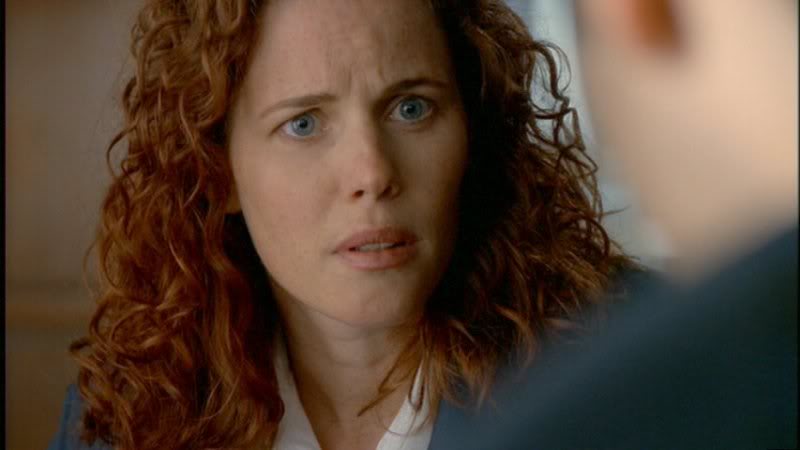
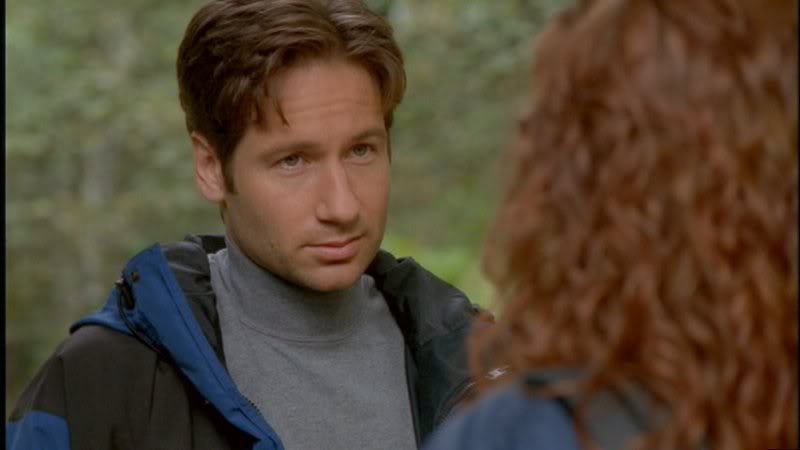
-- The Apalachicola National Forest, which is the largest U.S. National Forest in the state of Florida. It contains 564,961 acres and is the only national forest located in the panhandle of Florida.
-- Oopsie! In the Season 5 DVD release, the first season to be released in widescreen format, viewers could see that Mulder was wearing jeans in the car ride, first scene after the credits. However, when he exited the car, he was wearing dress slacks.
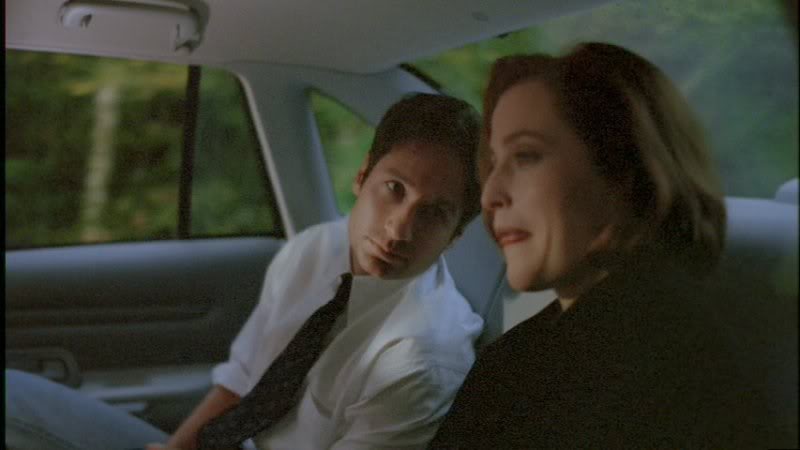
-- "Try any of the Tailhook crap on me, Scully, I'll kick your ass." Mulder was referencing the Tailhook Scandal, which arose out of the 1991 convention of the Tailhook Association, a private group whose members were associated with the Navy and its officer corps. Eighty-three women attending, including some enlisted women, reported being sexually assaulted or harassed in the Las Vegas, Nevada, hotel where the convention took place. As a result, the Navy withdrew its recognition of the organization, some enlisted men were fined or disciplined, and the then secretary of the Navy, Lawrence H. Garrett III, resigned. The chief of Naval operations, Admiral Frank B. Kelso II, was also persuaded into early retirement as a result of the incident.
-- Louis Asekoff was watching the 1933 horror movie, The Invisible Man. The film was based on the H.G. Wells science fiction novel, published in 1897.
-- The Indian Guide Program was developed through the YMCA by Harold S. Keltner, St. Louis YMCA Director, to support the father’s vital family role as teacher, counselor, and friend to his son. In 1926 he organized the first tribe in Richmond Heights, Missouri, with the help of his good friend, Joe Friday, an Ojibway Indian, and William H. Hefelfinger, Chief of the first Y-Indian Guide tribe. Keltner was inspired to organize the Indian Guide Program while on a hunting trip in Canada with Friday, who served as his guide on fishing and hunting trips. Sitting around the campfire one evening, Friday said, "The Indian father raises his son. He teaches his son to hunt, to track, to fish, to walk softly and silently in the forest, to know the meaning and purpose of life and all he must know, while the white man allows the mother to raise his son." These comments struck home, and Keltner arranged for Friday to work with him at the St. Louis YMCA. The program grew to include mothers and daughters, fathers and daughters and mothers and sons. Today, more than 180,000 pairs of parents and children, mostly ages 5 to 11, participate through some 500 Y chapters nationwide. In 2002, the YMCA changed the program's curriculum to the nature-based "Adventure Guides" in an effort to be more sensitive to Native Americans.
-- The Mothman was a creature reportedly seen in the Charleston and Point Pleasant areas of West Virginia from November 1966 through December 1967. Most observers described the Mothman as a winged man-sized creature with large reflective red eyes and large moth-like wings. The creature was sometimes reported as having no head, with its eyes set into its chest; and its appearance was said to foretell disasters. Calling the creature a "mothman" was the invention of an Ohio newspaper copyeditor after the first news stories of the "big bird" sightings appeared. There is a 12-foot tall stainless steel sculpture of the creature in Point Pleasant.
-- A large collection of first-hand material about the Mothman is found in John Keel's 1975 book, The Mothman Prophecies, in which Keel laid out the chronology of the Mothman and what he claimed to be related para-psychological events in the area, including UFO activity, Men in Black encounters, poltergeist activity, Bigfoot and black panther sightings, animal and human mutilations, precognitions by witnesses, and the December 15, 1967, collapse of the Silver Bridge spanning the Ohio River. Keel's first book was the basis of the 2002 film, The Mothman Prophecies, which starred Richard Gere, Laura Linney, Debra Messing, and Will Patton, and directed by Mark Pellington. A companion book, The Eighth Tower, also released in 1975, was derived from material edited from The Mothman Prophecies by the publishers.


-- While trying to get a fire started, Scully managed to pry apart a bullet with her bare hands in an attempt to use the gunpowder inside the casing to ignite the fire. In reality, this would be nearly impossible, as the brass of the casing is crimped around the bullet, forming a seal so tight that it would require the use of cutting tools to actually remove the bullet.
-- Yabba Dabba Doo! Flintstones, meet the Flintstones, they're a modern stone-age family ... In addition to inspiring some Mulder and Scully fireside conversation, The Flintstones was the first animated situation comedy shown in prime-time television, premiering on ABC in September 1960. It gained high ratings its first season, thus establishing animation as a viable prime time format. Produced by Bill Hanna and Joe Barbera, The Flintstones was designed as a program for the entire family and was patterned after Jackie Gleason's The Honeymooners. In fact, Gleason considered suing Hanna-Barbera for copying his series, but decided to let it pass, not wanting to be known as the man who forced the wildly popular Flintstones off the air.
-- The Flintstones featured Fred and Wilma Flintstone and their best friends Barney and Betty Rubble, who lived in the prehistoric town of Bedrock, but who faced the problems of contemporary working-class life. After a day at the rock quarry, Fred and Barney arrived home in a vehicle with stone wheels. Their lives revolved around their home, friends, and leisure activities, including their Water Buffalo lodge. A baby dinosaur and a saber tooth tiger replaced the family dog and cat. In 1962 and 1963, Pebbles and Bamm Bamm were introduced as the daughter and adopted son of the Flintstones and Rubbles, respectively.
-- Aside from being the first animated series made for prime time, The Flintstones also broke new ground in that each episode contained only one story that lasted the full half-hour. The Flintstones also used limited animation techniques, which created an assembly line method of creating drawings, combined with reduced and simplified body movement, which made it possible to manufacture animation cells more cheaply. The Flintstones helped establish Hanna-Barbera Productions as a major Hollywood animation studio and by the late 1960s as the world's largest producer of animated entertainment films. The Flintstones also launched a multi-million dollar merchandising business with hundreds of toys and novelties placed on the market, including the enduring Flintstones Vitamins (which did not feature a likeness of the well-endowed Betty) .
-- The Flintstones played on ABC in prime time through September 1966. It was the longest running prime-time animated series until it was surpassed by The Simpsons three decades later. The show also inspired a moderately successful live-action film in 1994, which starred John Goodman and Elizabeth Perkins as Fred and Wilma and Rick Moranis and Rosie O'Donnell as Barney and Betty and featured appearances by Elizabeth Taylor and Halle Berry. A 2000 sequel, in which none of the stars of the original film appeared, was a box office flop.
-- Mulder seemed to have a Season 5 fascination with the Ice Capades; he mentioned it in this episode and in "Mind's Eye" later in the season. The Ice Capades was a traveling ice skating entertainment show featuring theatrical performances by former Olympic and National Champion figure skaters who had retired from amateur competition. The Ice Capades was started in 1940 in Hershey, Pennsylvania, by nine managers of well-known entertainment arenas of the day who wanted to develop an ice show to play in their venues during the 1940-1941 entertainment seasons. They were inspired by the popularity of figure skating displays which were held during the intermissions between periods of hockey games. The managers chose the name Ice Capades and formed a group of skaters. The show grew rapidly and prospered for 50 years, finally going out of business around 1995.
-- The song that Scully used to serenade an injured Mulder, Joy to the World, was written by country singer Hoyt Axton, who was born in 1938 in Duncan, Oklahoma, the son of a naval officer and his English teacher wife. Raised primarily in Jacksonville, Florida, he studied classical piano as a child before switching to guitar, writing his first songs at 15. Despite the musical impact of his mother, Mae Boren Axton -- the co-author of Elvis Presley's landmark 1956 chart-topper Heartbreak Hotel -- he initially pursued a career in athletics, attending Oklahoma State University on a football scholarship before serving a stint in the Navy. From there, Axton relocated to San Francisco, performing at local folk clubs and in 1962 writing his fist hit, the Kingston Trio's Greenback Dollar. Later that year he recorded his first album, The Balladeer. A concurrent appearance on the television western Bonanza launched his acting career.
-- A friend's fatal drug overdose inspired Axton's song The Pusher, a hit for the rock band Steppenwolf subsequently included on the soundtrack for the film Easy Rider. Despite his success as a songwriter, Axton's performing career failed to catch fire, and he was without a recording contract for several years. In 1969 he signed with Columbia Records and recorded a new album. While opening for the band Three Dog Night to promote the album, the band heard his composition Joy to the World and asked to record it. Their recording of the song topped the pop charts in the spring of 1971, and early the following year they returned to the Top Ten with Axton's Never Been to Spain.
-- Axton appeared in dozens of television shows in the 1960s and 70s, including I Dream of Jeannie and McCloud and landed his first major film work in 1979 in the acclaimed family drama, The Black Stallion. Axton's subsequent movie roles included co-starring appearances in projects including 1983's Heart Like a Wheel, 1984's Gremlins, and 1989's We're No Angels. Axton suffered a stroke in 1996 and his health continued to decline; after a series of heart attacks, he died in October 1999 at the age of 61.
-- The rock band Three Dog Night had many top ten hits between 1969 and 1974, 21 consecutive top 40 hits, and 12 straight gold LPs. They had three U.S. number one hits, Mama Told Me Not to Come, (written by Randy Newman), Black and White, and Joy to the World. On a number of the band's early recordings, one of their in-studio background singers was Donna Gaines, who would later find stardom on her own as Donna Summer.
-- The band's name was suggested by June Fairchild, the then-girlfriend of the band's vocalist Danny Hutton, who read a magazine article about indigenous Australians in which it was explained that on cold nights they would customarily sleep in a hole in the ground while embracing a dingo, a native species of wild dog. On colder nights they would sleep with two dogs, and if a night was especially cold, it was a "Three Dog Night." The band took a break in 1975, but by 1981 they were ready to perform again and haven't stopped since. The band continues to tour and perform extensively 40 years after their first hit.
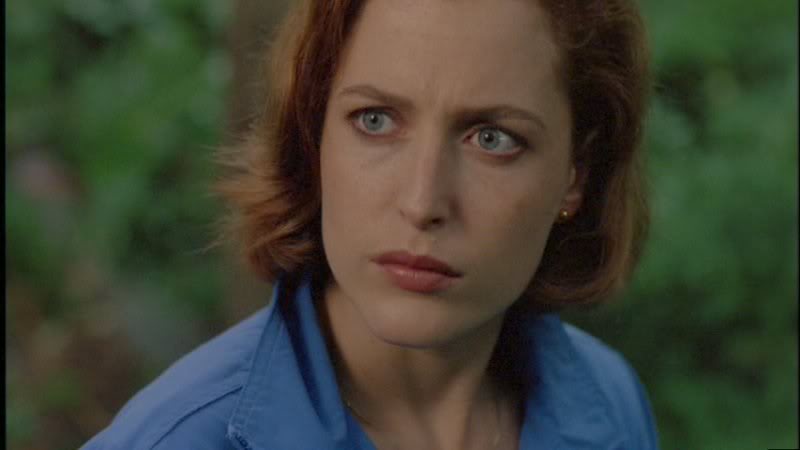
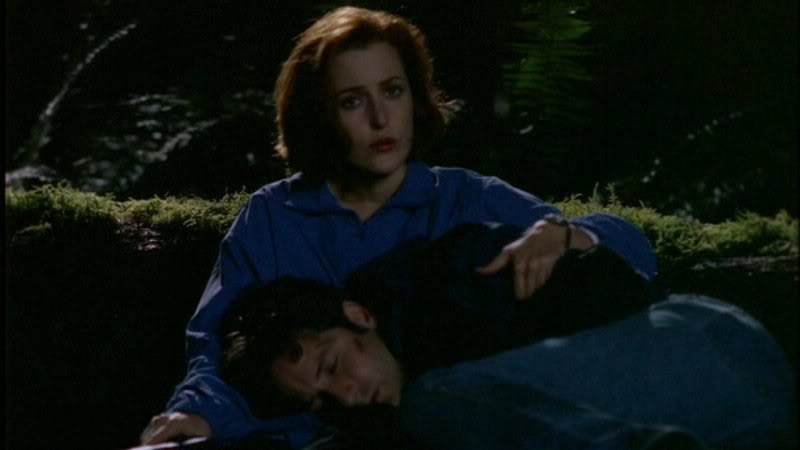
-- Scott Burkholder (Agent Kinsley) played an evangelist in The Rapture, which starred David Duchovny and Mimi Rogers.
-- J. C. Wendel (Agent Stonecypher) played Dave's assistant on Dave's World, the series based loosely on the life of Dave Barry which starred Harry Anderson.
-- Anthony Rapp who played the nerdy technician Jeff Glaser, was one of the original stars of the Broadway musical Rent. He took ten days off from the show to work on The X-Files. Rapp reprised his role of Mark Cohen in the movie version of the musical. Another Rent alumnus, Jesse L. Martin, appeared in the Season 7 episode, "The Unnatural."
-- The character of Michele Fazekas was named for co-executive producer Frank Spotnitz's assistant. Fazekas' name was also used in Season 4's "Demons" (ill-fated police officer Michael Fazekas).
-- Colleen Flynn, who played Michele Fazekas, would appear on the X-Files again in Season 7's "all things." She may be best known for playing a young wife who died giving birth in a memorable 1995 episode of ER, entitled "Love's Labor Lost."
-- Their outdoor attire forces one to wonder how Mulder and Scully decided what to pack for their trip to Florida. During their excursion to the forest, Mulder wore a medium-weight jacket and turtleneck, and Scully wore a light-weight jacket and thin top.
-- Like so many episodes, "Detour" ended with one of the monsters still at large. "We loved the endings that left the audience unsettled at the end," Frank Spotnitz said. "Nothing pleased me more than when I would talk to a viewer who said they really couldn't go to sleep that night, or they kept double-checking their windows and doors. It's scarier if you think he could still be out there."
-- Once & Future Retreads: Colleen Flynn (Michele Fazekas) was Colleen Azar in "all things." Merrilyn Gann (Mrs. Asekoff) was the Prosecuting Attorney in "Young at Heart." Alfred Humphreys (Michael Asekoff) was Mission Controller #2 in "Space" and Dr. Pomerantz in "The Blessing Way." Tom Scholte (Michael Sloan) was Young Johanson in "Piper Maru."
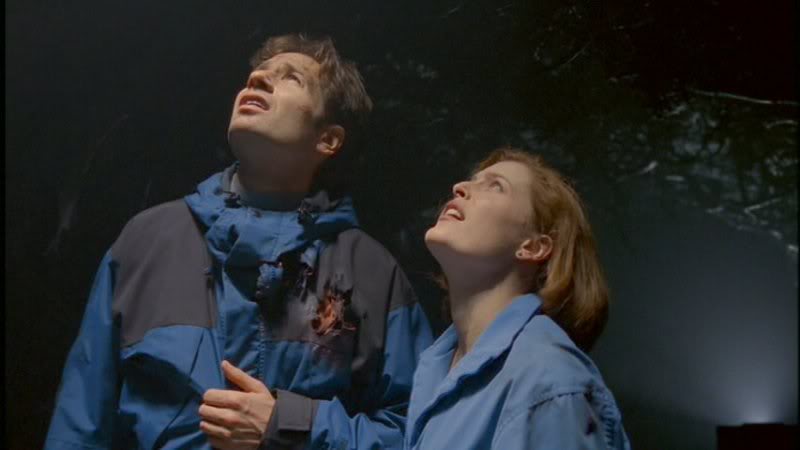
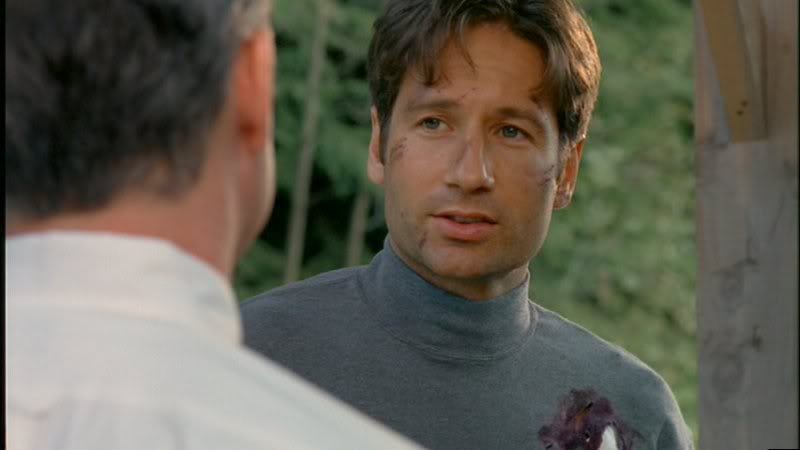
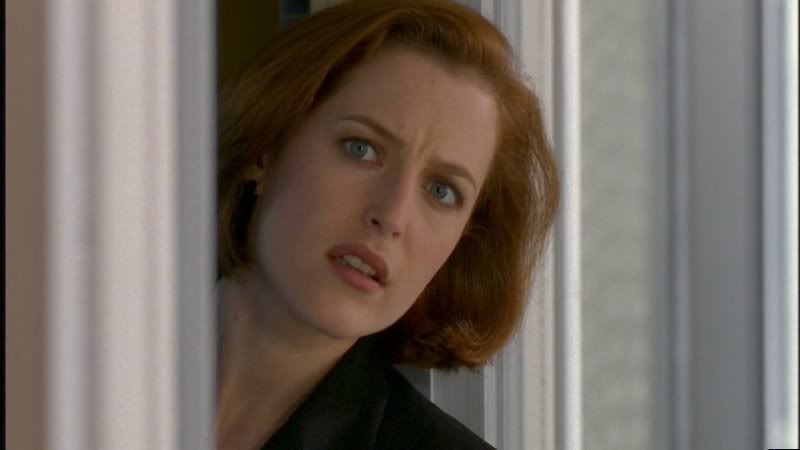
(Thanks to chrisnu for today's pics.)
Please share your first impressions, favorite (or cringe-worthy) moments, classic lines, favorite fanfic, nagging questions, repeated viewing observations, etc., as today we celebrate "Detour."
Polly